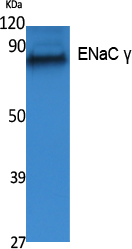ENaC γ Polyclonal Antibody
- Catalog No.:YT5032
- Applications:WB;ELISA
- Reactivity:Human;Mouse;Rat
- Target:
- ENaC γ
- Fields:
- >>Taste transduction;>>Aldosterone-regulated sodium reabsorption
- Gene Name:
- SCNN1G
- Protein Name:
- Amiloride-sensitive sodium channel subunit gamma
- Human Gene Id:
- 6340
- Human Swiss Prot No:
- P51170
- Mouse Gene Id:
- 20278
- Mouse Swiss Prot No:
- Q9WU39
- Rat Gene Id:
- 24768
- Rat Swiss Prot No:
- P37091
- Immunogen:
- The antiserum was produced against synthesized peptide derived from human ENaC gamma. AA range:132-181
- Specificity:
- ENaC γ Polyclonal Antibody detects endogenous levels of ENaC γ protein.
- Formulation:
- Liquid in PBS containing 50% glycerol, 0.5% BSA and 0.02% sodium azide.
- Source:
- Polyclonal, Rabbit,IgG
- Dilution:
- WB 1:500 - 1:2000. ELISA: 1:20000. Not yet tested in other applications.
- Purification:
- The antibody was affinity-purified from rabbit antiserum by affinity-chromatography using epitope-specific immunogen.
- Concentration:
- 1 mg/ml
- Storage Stability:
- -15°C to -25°C/1 year(Do not lower than -25°C)
- Other Name:
- SCNN1G;Amiloride-sensitive sodium channel subunit gamma;Epithelial Na(+) channel subunit gamma;ENaCG;Gamma-ENaC;Gamma-NaCH;Nonvoltage-gated sodium channel 1 subunit gamma;SCNEG
- Observed Band(KD):
- 80kD
- Background:
- Nonvoltage-gated, amiloride-sensitive, sodium channels control fluid and electrolyte transport across epithelia in many organs. These channels are heteromeric complexes consisting of 3 subunits: alpha, beta, and gamma. This gene encodes the gamma subunit, and mutations in this gene have been associated with Liddle syndrome. [provided by RefSeq, Apr 2009],
- Function:
- disease:Defects in SCNN1G are a cause of Liddle syndrome [MIM:177200]. It is an autosomal dominant disorder characterized by pseudoaldosteronism and hypertension associated with hypokalemic alkalosis. The disease is caused by constitutive activation of the renal epithelial sodium channel.,function:Sodium permeable non-voltage-sensitive ion channel inhibited by the diuretic amiloride. Mediates the electrodiffusion of the luminal sodium (and water, which follows osmotically) through the apical membrane of epithelial cells. Controls the reabsorption of sodium in kidney, colon, lung and sweat glands. Also plays a role in taste perception.,PTM:Phosphorylated on serine and threonine residues.,PTM:Ubiquitinated; this targets individual subunits for endocytosis and proteasome-mediated degradation.,similarity:Belongs to the amiloride-sensitive sodium channel family.,subcellular location:Apical me
- Subcellular Location:
- Apical cell membrane ; Multi-pass membrane protein . Apical membrane of epithelial cells. .
- Expression:
- Expressed in kidney (at protein level).
Alcohol inhibits alveolar fluid clearance through the epithelial sodium channel via the A2 adenosine receptor in acute lung injury. Molecular Medicine Reports Mol Med Rep. 2021 Oct;24(4):1-13 IHC,WB Mouse 1:200,1:1000 Lung
- June 19-2018
- WESTERN IMMUNOBLOTTING PROTOCOL
- June 19-2018
- IMMUNOHISTOCHEMISTRY-PARAFFIN PROTOCOL
- June 19-2018
- IMMUNOFLUORESCENCE PROTOCOL
- September 08-2020
- FLOW-CYTOMEYRT-PROTOCOL
- May 20-2022
- Cell-Based ELISA│解您多样本WB检测之困扰
- July 13-2018
- CELL-BASED-ELISA-PROTOCOL-FOR-ACETYL-PROTEIN
- July 13-2018
- CELL-BASED-ELISA-PROTOCOL-FOR-PHOSPHO-PROTEIN
- July 13-2018
- Antibody-FAQs
- Products Images

- Western Blot analysis of extracts from A549 cells, using ENaC γ Polyclonal Antibody. Antibody was diluted at 1:500. Secondary antibody(catalog#:RS0002) was diluted at 1:20000

- Western blot analysis of lysates from A549 cells, using ENaC γ antibody.



